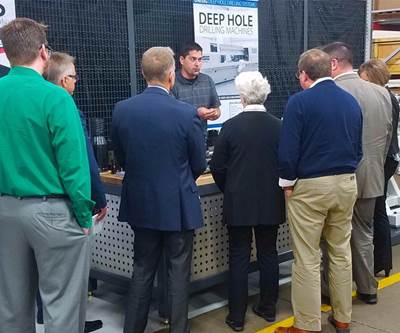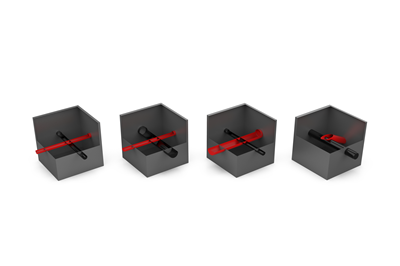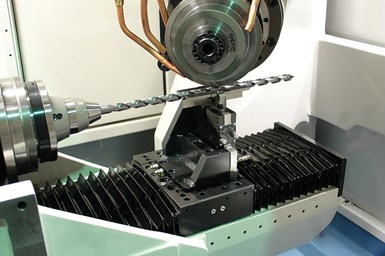
Typical deep-hole drilling processes include gundrilling, BTA drilling and carbide twist drills. Photo Credit: ANCA CNC Machines
Understanding the deep-hole drilling process and being aware of common problems turns a complex operation into a productive and profitable one. Deep-hole drilling produces holes in metal at high depth-to-diameter ratios on CNC machines. The length-to-diameter ratio is less than five times the diameter for normal drilling processes. The process is called deep-hole drilling if the length-to-diameter ratio goes beyond five.
Deep-hole drilling is effective in diameters ranging from 1–200 millimeters (0.04–8.00 inches). It requires special drills with through-coolant holes that deliver high-pressure coolant to evacuate chips cleanly and achieve required hole tolerances and surface finish.
Process Review
Some standard deep-hole drilling processes include gundrilling, BTA drilling (boring and trepanning association) and conventional carbide twist drills, each offering benefits based on hole diameter and tolerances.
- BTA drilling is an effective method of drilling deep holes, as it is cleaner, reliable and capable of achieving larger diameters at higher feed rates. BTA drilling is effective in holes from 20–200 millimeters (0.80–8.00 inches), a more extensive size range than gundrilling and carbide twist drills.
- Gundrilling was originally developed to drill out gun barrels and is commonly used for drilling smaller diameter deep holes. The depth-to-diameter ratio can be even greater than 300:1. The critical feature of gundrilling is that the bits are self-centering, which enables such deep, accurate holes.
- Carbide twist drills with through-coolant holes are also commonly used in several deep-hole drilling applications. The challenge is to manufacture and regrind these drills with minimal runout, which requires an additional axis on machines to support the flute grinding process.
One of the most significant challenges of deep-hole drilling is maintaining control of runout, which increases with cutting tool length.
Three Ways to Conquer Deep-Hole Drilling Challenges
1. Through coolant or internal coolant. Coolant can improve chip evacuation while cooling the cutting edge. Coolant is flushed down to the bottom of the hole, pushing the chips back up toward the top. Software is available that helps design and verify the coolant holes at the design stage, avoiding coolant holes breakage into flutes and eliminating scrap.
2. Hole straightness. The “margin or radial land” is the portion of the drill that contacts the hole. A single-margin drill (one margin per flute) is preferred in long-chipping materials. This is because single-margin drills provide additional clearance in the longer chipping materials. In contrast, a double-margin drill (two margins per flute) provides excellent hole straightness compared with a single-margin drill.
Although not as common, double-margin drills with a floating second margin are also available where a compromise can be made on hole straightness and chip evacuation, so more margins add accuracy while maintaining a higher surface finish but restrict the amount of clearance for chip evacuation.
3. Tool runout control. One of the most significant challenges of deep-hole drilling is maintaining control of runout, which increases with cutting tool length. Consider a more accurate method of toolholding that can deliver minimal runout and longer cutting tool life that includes a high-precision collet adapter and tool support system.
Related Content
Developments in High-Speed Machining Technology
There have been many exciting developments in high-speed machining relative to machining centers and controls, tooling and CAD/CAM systems.
Read More3D Printing Enables Better Coolant Delivery in Milling Operations
Just like 3D printing enabled conformal cooling channels in molds, additive manufacturing is now being used to optimize coolant delivery in cutting tools.
Read MoreThe Benefits of Hand Scraping
Accuracy and flatness are two benefits of hand scraping that help improve machine loop stiffness, workpiece surface finish and component geometry.
Read MoreHow to Analyze and Optimize Cutting Conditions to Reduce Cycle Time
Plastic injection mold design and manufacturing company puts NC program optimization software module to the test. The results were surprising.
Read MoreRead Next
Lessons Learned in Deep Hole Drilling
Of course when it comes to deep hole drilling, the tooling, the fixturing and the automation are all essential, but the part that caught my attention during a recent UNISIG event was the focus on mold-specific industry solutions, especially its USC-M series machines that allow multiple operations to be performed on all workpiece sides with one setup.
Read MoreHow to Overcome Deep-Hole Drilling Obstacles in Mold Machining
Keep up with the newest tooling innovations to overcome holemaking and finishing challenges.
Read MoreDeep-Hole Drilling and Milling Machines Streamline Moldmaking
UNISIG says its deep-hole drilling and milling machines reduce setup time, increase accuracy and eliminate mold design restrictions.
Read More


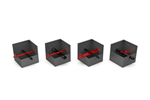
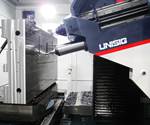




.jpg;maxWidth=300;quality=90)










